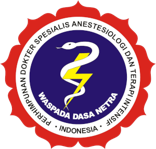Perioperative Management of Patients with Ventricular Septal Defect, Severe Tricuspid Regurgitation and Gerbode Defects
Abstract
Ventricular Septal Defect (VSD) is a congenital heart disease that causes the connection between left and right ventricles called a Gerbode defect. Manifestation of a Gerbode defect is damage to the opening tricuspid valve caused regurgitation of the tricuspid valve. Delay in diagnosis and intervention will affect pre-operative nutritional status and malnutrition.
We reported a boy aged 2 months, weighing 3100 grams with biliary atresia followed by VSD, severe TR, and Gerbode defect who will undergo the Kasai procedure. Preoperative physical examination showed GCS E4V5M6, SpO2 100%. The skin gets icteric all over the body and conjunctiva. The cardiovascular system has a regular I-II heart sound, 2/3 mid clavicular S noise as high as 2 ICS and a pansystolic murmur. The examination of the abdomen is slight distended. Child pug score 8. Hemoglobin value 6.7gr%, hematocrite 37%, APTT 44.8 seconds, SGOT 443 U / L, SGPT 560 U / L, total bilirubin 23.89 mg / dl, direct bilirubin 13.92 mg / dl, and indirect bilirubin 9.97 mg / dl.
The goal of anesthesia in VSD, Severe Tricuspid Regurgitation (TR) with Gerbode Defect is preventing excessive ventilation to avoid severe pulmonary hypertension. The choice of anesthetic agent is based on the patient's physiology and balancing pulmonary and systemic blood flow. Perioperative management of cases of VSD, TR Severe with Gerbode defect in the following report describes the importance of understanding the pathophysiology of VSD and Gerbode defects to obtain a good outcome.
Perioperative management of VSD patients, severe tricuspid regurgitation with Gerbode defect requires more supervision, especially to minimize the increase in PVR, maintain systemic vascular resistance (SVR) and avoid excessive ventilation to prevent severe pulmonary hypertension.
Keywords
Full Text:
PDFReferences
Demirkol S, Yesil FG, Bozlar U, Balta S, Sahin MA, Guler A. Multimodality imaging of a congenital Gerbode defect. 2016; 71: 104 2. Sinisalo JP, Sreeram N, Jokinen E, Qureshi SA. Acquired left ventricular-right atrium shunts. Eur J Cardiothorac Sur, 2015; 39: 500-506. 3. Saker E, Bahri GN, Montalbano MJ, Johal J, Graham RA, Tardieu GG. Gerbode defect: A comprehensive review of its history, anatomy, embryology, pathophysiology, diagnosis, and treatment. J Saudi Heart Assoc,2017; 29: 283-292. 4. Dadkhah R, Friart A, Leclerc JL, Moreels M, Haberman D, Lienart F. Uncommon acquired Gerbode defect (left ventricular to right atrial communication) following a tricuspid annuloplasty without concomitant mitral surgery. Eur J Echocardiogr, 2014; 10: 579-581. 5. Dzwonczyk T, Davidson WR. The spectrum of left ventricular-right atrial communications in the adult: Essentials of echocardiographic assessment. Journal of the American Society of Echocardiography, 2015; 8: 263-269. 6. Roselli EE. Reoperative cardiac surgery: Challenges and outcomes. Tex Heart Inst J, 2016; 38: 669-671. 7. Schmitz ML, Ullah S, Dasgupta R, Thompson LL. Anesthesia for Right-sided Obstructive Lesions: Anesthesia for Congenital Heart Disease 3rd Edition. John Wiley & Son New Jersey. 2015; 517-524. 8. Davis PJ dan Cladis FP. Smiths’s Anesthesia for Infant and Children 9th Edition. Philadelphia: Elsevier, 2017; 1131-1333. 9. Bisri DY, Bisri T. Dasar-dasar Neuroanestesi Edisi ke-4. Bandung: Fakultas Kedokteran Universitas Padjajaran, 2019; 7-28 10. Saleh SC. Sinopsis neuroanestesia klinik. Sidoarjo: Zifatama, 2018; 109-124 11. Soriano SG, McManus ML. Pediatric Neuroanesthesia and Critical Care: Cottrell and Patel’s Neuroanaesthesia. 6th ed. Philadelphia: Elsevier, 2017; 338-348 12. Yen P. ASD and VSD flow dynamics and anesthetic management. Anesth Prog 2015; 62:125‑30. 13. Roberts JD Jr., Romanell TM, Todres D. Neonatal Emergencies – A Practice of Anaesthesia for Infants and Children. 4th ed. Philadelphia: Saunders, 2018; 758‑9.
Refbacks
- There are currently no refbacks.








